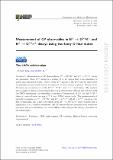Measurement of CP observables in B± → D(*)K± and B± → D(*)π± decays using two-body D final states
Author(s)
Aaij, R.; Abellán Beteta, C.; Ackernley, T.; Adeva, B.; Adinolfi, M.; Afsharnia, H.; Aidala, C. A; Aiola, S.; Ajaltouni, Z.; Akar, S.; Albrecht, J.; Alessio, F.; Alexander, M.; Alfonso Albero, A.; Aliouche, Z.; Alkhazov, G.; ... Show more Show less
Download13130_2021_Article_15338.pdf (7.706Mb)
Publisher with Creative Commons License
Publisher with Creative Commons License
Creative Commons Attribution
Terms of use
Metadata
Show full item recordAbstract
Abstract
Measurements of CP observables in B± → D(*)K± and B± → D(*)π± decays are presented, where D(∗) indicates a neutral D or D∗ meson that is an admixture of meson and anti-meson states. Decays of the D(∗) meson to the Dπ0 and Dγ final states are partially reconstructed without inclusion of the neutral pion or photon. Decays of the D meson are reconstructed in the K±π∓, K+K−, and π+π− final states. The analysis uses a sample of charged B mesons produced in proton-proton collisions and collected with the LHCb experiment, corresponding to integrated luminosities of 2.0, 1.0, and 5.7 fb−1 taken at centre-of-mass energies of 7, 8, and 13 TeV, respectively. The measurements of partially reconstructed B± → D(*)K± and B± → D(∗)π± with D → K∓π± decays are the first of their kind, and a first observation of the B± →
D
π
0
D
∗
π
±
$$ {\left(D{\pi}^0\right)}_{D^{\ast }}{\pi}^{\pm } $$
decay is made with a significance of 6.1 standard deviations. All CP observables are measured with world-best precision, and in combination with other LHCb results will provide strong constraints on the CKM angle γ.
Date issued
2021-04-09Department
Massachusetts Institute of Technology. Department of PhysicsPublisher
Springer Berlin Heidelberg
Citation
Journal of High Energy Physics. 2021 Apr 09;2021(4):81
Version: Final published version